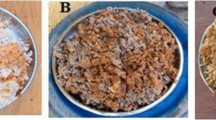Abstract
Objectives
To qualitatively and quantitatively characterize a low molecular weight phenolic fraction (LMF) of Malbec wine from Cafayate, Argentina, and evaluate its effect on viability and exopolysaccharide production of Pediococcus pentosaceus 12p, a wine spoilage bacterium.
Results
The phenolic compounds detected were, in general, comparable to data previously reported but hydroxycinnamic acids were detected at higher concentrations than determined in other studies. Addition of LMF at identical concentrations present in wine or a four times concentrated LMF mixture to a synthetic wine-like medium produced a diminution in bacterial viability and exopolysaccharide production in the supernatant culture. Transmission electron microscopy revealed damage of bacterial cell integrity after 96 h of incubation only in the presence of four times concentrated LMF.
Conclusion
This is the first time a low molecular weight phenolic fraction has been characterized in Cafayate wine and it has demonstrated a marked antimicrobial effect on an exopolysaccharide-producing wine spoilage bacterium.

Similar content being viewed by others
References
Aredes Fernandez PA, Saguir FM, Manca de Nadra MC (2003) Effect of amino acids and peptides on growth of Pediococcus pentosaceus from wine. Lat Am Appl Reser 33:135–139
Campos FM, Couto JA, Figueiredo AR, Tóth IV, Rangel AOSS, Hogg TA (2009) Cell membrane damage induced by phenolic acids on wine lactic acid bacteria. Int J Food Microbiol 135:144–151
Cicco N, Lanorte MT, Paraggio M, Viggiano M, Lattanzio V (2009) A reproducible, rapid and inexpensive Folin-Ciocalteu micro-method in determining phenolics of plant methanol extracts. Microchem J 91:107–110
Dubois M, Gilles KA, Hamilton JK, Rebers PA, Smith F (1956) Colorimetric method for determination of sugars and related substances. Anal Chem 28:350–356
Fanzone M, Zamora F, Jofré V, Assof M, Gómez Cordovés C, Peña Neira A (2011) Phenolic characterization of red wines from different grape varieties cultivated in Mendoza province (Argentina). J Sci Food Agric 24:154–159
García-Ruiz A, Bartolomé B, Cueva C, Martín-Álvarez PJ, Moreno-Arribas MV (2009) Inactivation of oenological lactic acid bacteria (Lactobacillus hilgardii and Pediococcus pentosaceus) by wine phenolic compounds. J Appl Microbiol 107:1042–1053
García-Ruiz A, Moreno-Arribas MV, Martín-Álvarez PJ, Bartolomé B (2011) Comparative study of the inhibitory effects of wine polyphenols on the growth of enological lactic acid bacteria. Int J Food Microbiol 145:426–431
García-Ruiz A, Cueva C, González-Rompinelli EM, Yuste M, Torres M, Martín-Álvarez PJ, Bartolomé B, Moreno-Arribas MV (2012) Antimicrobial phenolic extracts able to inhibit lactic acid bacteria growth and wine malolactic fermentation. Food Control 28:212–219
Ghiselli A, Nardini M, Baldi A, Scaccini C (1998) Antioxidant activity of different phenolic fractions separated from an Italian red wine. J Agr Food Chem 46:361–367
Guerrero RF, Cantos Villar E (2015) Demonstrating the efficiency of sulphur dioxide replacements in wine: a parameter review. Trends Food Sci Tech 42:27–43
Harborne JB, Williams CA (2000) Review: advances in flavonoid research since 1992. Phytochemistry 55:441–504
Karnovsky MJA (1965) Formaldehyde glutaraldehyde fixative of high osmolality for use in electron microscopy. J Cell Biol 27:137–138
La Torre GL, Saitta M, Vilasi F, Pellicano T, Dugo G (2006) Direct determination of phenolic compounds in Sicilian wines by liquid chromatography with PDA and MS detection. Food Chem 94:640–650
Lonvaud-Funel A, Guilloux Y, Joyeux A (1993) Isolation of a DNA probe for identification of glucan-producing Pediococcus damnosus in wines. J Appl Bacteriol 74:41–47
Manca de Nadra MC, Strasser de Saad AM (1995) Polysaccharide production by Pediococcus pentosaceus from wine. Int J Food Microbiol 27:101–106
Millet V, Lonvaud-Funel A (2000) The viable but non-culturable state of wine microorganisms during storage. Lett Appl Microbiol 2:136–141
Ribéreau-Gayon P, Dubourdieu D, Doneche B, Lonvaud A (2006) Handbook of enology-volume 1- the microbiology of wine and vinifications, 2nd edn. Wiley, Chichester
Stivala MG, Villecco MB, Fanzone M, Jofré V, Rodríguez-Vaquero MJ, Aredes-Fernández P (2014) Characterization, antibacterial and biological activities of phenolic fraction of Argentinean red wines. Open Conf Proc J 5:29–37
Strasser de Saad AM, Manca de Nadra MC (1987) Isolation and identification of the lactic acid bacteria from Cafayate (Argentina) wines. Microbiol Aliments Nutr 5:45–49
Venable JR, Coggeshall R (1965) A simplified lead-citrate stain for use in electron microscopy. J Cell Biol 25:407–408
Walling E, Dols-Lafargue M, Lonvaud-Funel A (2005) Glucose fermentation kinetics and exopolysaccharide production by ropy Pediococcus damnosus IOEB8801. Food Microbiol 22:71–78
Acknowledgments
The authors wish to thank the Agencia Nacional de Promoción Científica y Técnica (ANPCYT) and Consejo Nacional de Investigaciones Científicas y Técnicas (CONICET).
Author information
Authors and Affiliations
Corresponding author
Rights and permissions
About this article
Cite this article
Stivala, M.G., Villecco, M.B., Fanzone, M. et al. Characterization of the phenolic fraction from Argentine wine and its effect on viability and polysaccharide production of Pediococcus pentosaceus . Biotechnol Lett 37, 2435–2444 (2015). https://doi.org/10.1007/s10529-015-1933-y
Received:
Accepted:
Published:
Issue Date:
DOI: https://doi.org/10.1007/s10529-015-1933-y




